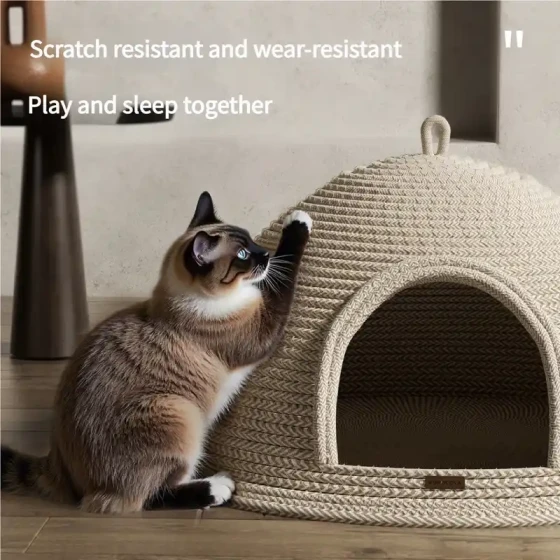What to Do If Your Cat Has Ringworm_Teaching You Effective Methods to Correctly Handle Cat Ringworm
If your cat has ringworm, it is usually a fungal infection that requires timely treatment, including topical medication, systemic treatment (if necessary), and thorough environmental disinfection to prevent disease spread and help your cat recover quickly.
Ringworm, medically known as dermatophytosis, is a common skin infection caused by fungi, especially prone to spread among kittens, elderly cats, or cats with weakened immune systems. It not only damages the cat’s skin and causes hair loss but may also infect other pets and even humans. Therefore, once you discover your cat has ringworm, timely and correct treatment is crucial.

What Is Ringworm? Why Does My Cat Get Ringworm?
Simply put, ringworm means your cat’s skin is "moldy." Many types of fungi cause ringworm, the most common being Microsporum canis. The spores of this fungus are very resilient and can survive in the environment for a long time.
There are several ways cats get infected with ringworm:
* Direct contact: Direct contact with a cat or other animal having ringworm is the main transmission route.
* Indirect contact: Contact with items contaminated by fungal spores, such as cat beds, combs, toys, floors, etc. Imagine the fungal spores as invisible "seeds" attached to these objects, which can "take root" when healthy cats come into contact.
* Decreased immunity: Cats with malnutrition, stress, illness, or immature immune systems (such as kittens) are more susceptible to fungal invasion.
What Does Ringworm Look Like? How to Detect Early?
The most typical sign of ringworm is circular, well-defined areas of hair loss on your cat’s skin. These areas may be accompanied by:
* Red edges: The borders of the lesion may appear red or raised.
* Scales or crusts: The skin in hairless areas may be dry, flaky, or form thin crusts.
* Itching: Some cats itch from ringworm, frequently scratching or licking the affected areas, possibly leading to secondary bacterial infection.
Ringworm can appear anywhere on a cat’s body but often first appears on the head, ears, paws, and tail. Sometimes the signs are not typical, with only subtle hair loss or flaking, making early detection difficult. If you notice abnormal thinning or skin issues in any area, examine it closely.
Notably, ringworm is a zoonotic disease, meaning it can spread to humans. Humans infected with ringworm typically develop a red, ring-shaped rash on the skin that usually itches. Hence, when handling an infected cat, personal hygiene is essential—wear gloves and wash hands thoroughly after contact.
Suspect Ringworm? Be Sure to See a Vet!
Though symptoms may indicate ringworm, a veterinarian must confirm the diagnosis. Vets often use the following methods:
* Wood's lamp examination: In a dark room, a special ultraviolet light is shined on the cat’s fur. Certain ringworm fungi (though not all) fluoresce under Wood's lamp. This is only a preliminary screening and cannot definitively diagnose ringworm.
* Fungal culture: The most accurate diagnostic method. The vet will collect hair or skin scale samples from the affected area and culture them on special media. If fungi grow, ringworm is confirmed, and the fungal species can be identified. Culturing takes time, usually about a week or longer.
* Microscopic examination: Hair or scale samples viewed under a microscope may reveal fungal spores or hyphae.
Once ringworm is diagnosed, the vet will develop a treatment plan based on the cat’s age, health, extent, and severity of infection. Do not self-diagnose or administer medications at will to avoid worsening the condition or harmful side effects.
Treatment Methods for Cat Ringworm
Treating ringworm requires patience and persistence, generally including topical treatment, systemic treatment, and environmental disinfection.
- Topical treatment:
- Medicated baths: Use professional pet shampoos containing antifungal ingredients such as ketoconazole or miconazole. Follow instructions or your vet’s guidance, usually bathing 1-2 times per week. Baths help remove fungal spores from fur and relieve itching but prevent your cat from licking the foam.
- Topical creams or sprays: Your vet might prescribe antifungal ointments, lotions, or sprays to apply directly on lesions. Hair around the lesions should be trimmed to allow better skin contact. Prevent your cat from licking the medication by using an Elizabethan collar (the so-called “cone of shame”).
- Systemic treatment (oral medication):
- For widespread infections, severe cases, immunocompromised cats, or if topical treatment is ineffective, vets may recommend oral antifungal drugs such as itraconazole or terbinafine. Oral medications must be given strictly according to the vet’s dosage and duration since some drugs may affect the cat's liver, requiring regular health monitoring. Oral treatment typically lasts several weeks to months until fungal cultures show negative.
- Environmental disinfection:
- This vital step is often overlooked during treatment. As mentioned, fungal spores are highly resilient; if only the cat is treated without cleaning the environment, re-infection is very likely.
- Thorough cleaning: Vacuum floors, carpets, and furniture carefully; immediately dispose of or clean vacuum bags.
- Wash items: Wash cat beds, mats, toys, food and water bowls, and all contact items with hot water and detergent.
- Use disinfectants: Apply fungicidal disinfectants on floors, furniture, cat trees, etc. Diluted bleach (sodium hypochlorite) is an effective disinfectant (e.g., 1:10 dilution means 1 part bleach to 9 parts water); ensure good ventilation and wait until surfaces fully dry before the cat contacts them. Some pet-specific environmental disinfectants effective against fungi can also be used. Environmental disinfection should continue alongside treatment and may be needed for some time.
What to Pay Attention to During Treatment?
- Isolation: Separate the infected cat from other healthy pets to prevent fungal spread.
- Wear Elizabethan collar: To stop the cat from licking medication or scratching lesions, which may worsen infection or cause medication poisoning.
- Follow medication schedule: Strictly adhere to the vet’s treatment plan, avoid stopping or altering dosages arbitrarily. Fungal treatments require a full course to completely eradicate infection.
- Regular recheck: Visit the vet as scheduled for fungal cultures or other tests until the cat is confirmed fully recovered. Sometimes symptoms resolve but spores remain.
- Maintain dry environment: Fungi thrive in dampness; keeping indoor areas dry helps inhibit fungal growth.
- Boost cat’s health: Provide balanced nutrition and adequate rest to strengthen your cat’s immunity.
Frequently Asked Questions
- Can ringworm heal on its own? A few strong young cats with mild symptoms may self-heal, but it usually takes long and risks spreading to others and humans. Timely treatment shortens disease duration and reduces suffering and transmission risk.
- My cat has been vaccinated; can it still get ringworm? Ringworm is a fungal infection. Vaccines your cat got mainly prevent viral or bacterial diseases and do not protect against fungi.
- Does sunlight help with ringworm? Ultraviolet light has some fungicidal effects, but sun exposure alone is insufficient to treat ringworm. Moderate sun exposure benefits overall cat health but cannot replace medications.
- How long is the treatment for ringworm? Duration varies by individual cat and infection severity, usually several weeks to months. Cure is judged by disappearance of clinical signs and multiple consecutive negative fungal cultures.
- Can cats get ringworm again after curing? Yes, if exposed to fungal spores again or if their immunity drops. Keeping the environment clean and boosting the cat’s health is important.
Summary
Though ringworm in cats sounds troublesome, most cats can fully recover if you follow veterinary guidance patiently combined with medication and environmental disinfection. Remember early detection, timely vet visits, and consistent treatment are key to defeating ringworm. Throughout the process, give your cat plenty of love and patience to help them through the tough times!





